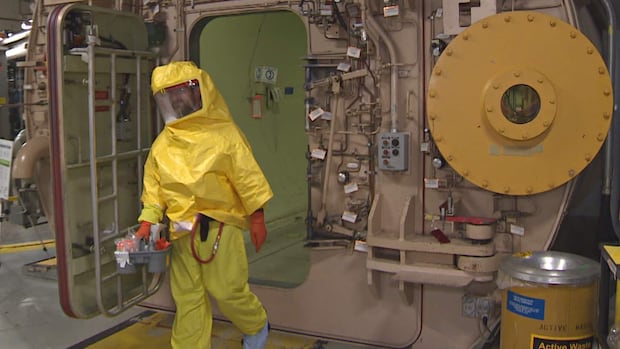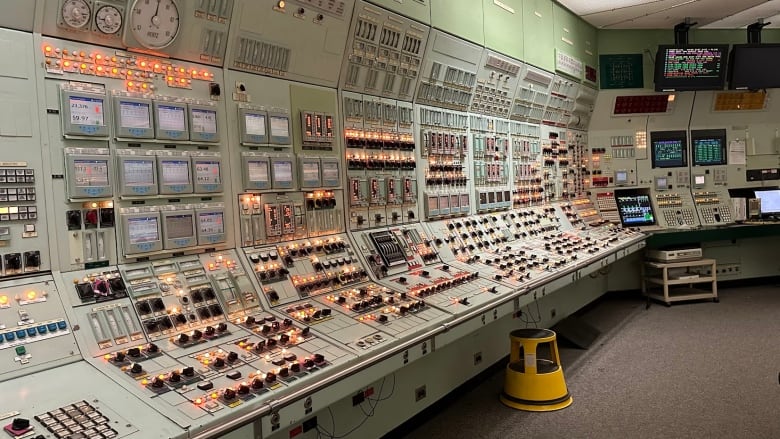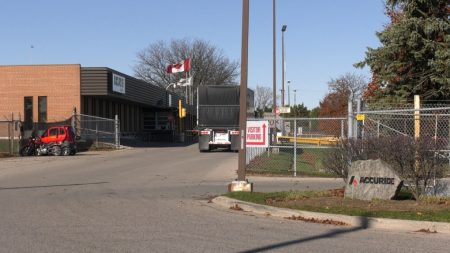The Ontario government announced Tuesday that it plans to refurbish the half-century old Pickering nuclear generating station, keeping the plant operating for at least another 30 years.
The announcement comes as demand for electricity in Ontario is forecast to increase sharply over the coming decades. Meanwhile, all provinces face federal clean electricity regulations that would require future power plants to produce net-zero carbon emissions.
Energy Minister Todd Smith announced the Ford government’s support of Ontario’s Power Generation’s (OPG) plan to refurbish the power plant.
“Our province still needs this station and its workers,” Smith said Tuesday at a news conference outside the nuclear plant.
“And this refurbishment, effectively a major overhaul of four of the generators, is going to have a huge impact once completely refurbished.”
The four nuclear units that would be refurbished are all Candu reactors that date back to the early 1980s, collectively known as Pickering B. The refurbishment would supply 2,000 megawatts of power, comparable to the current output of those existing units.
WATCH | Energy minister on province’s move to refurbish nuclear plant:
Pickering nuclear plant expected to be fully refurbished by mid-2030s: Energy minister
The Ontario government has announced plans to refurbish the Pickering nuclear generating station, a project expected to be completed by the mid-2030s. According to energy minister Todd Smith, the refurbishment would help keep the plant operating for at least another 30 years and create thousands of new jobs.
The news release says the refurbishment will take 11 years, create about 11,000 jobs per year and increase Ontario’s GDP by $19.4 billion, but it does not state the project’s total budget.
A similar refurbishment of four units at the nearby Darlington nuclear station is more than midway through completion, on a total budget of $12.8 billion.
“With global business looking to expand in jurisdictions with reliable, affordable and clean electricity, a refurbished Pickering Nuclear Generating Station would help Ontario compete for and land more game-changing investments,” Smith said in the release.
“The refurbishment of Pickering would create thousands of new jobs and help produce at least another 30 years of safe, reliable and clean electricity to power the next major international investment, the new homes we are building and industries as they grow and electrify.”
The plan is subject to approval by the Canadian Nuclear Safety Commission.
The City of Pickering produces about 14 per cent of the province’s electricity but its current licence to operate the four units in question expires at the end of this year.
The commission is already considering a previous OPG request to extend the operating licence of Pickering B’s existing units until 2026. That timeframe would allow the plant to keep generating electricity until it gets shut down to begin the refurbishment, if approved.
Ontario’s big nuclear plans
The Pickering announcement is just the latest in Ontario’s plans for what is poised to be Canada’s biggest-ever expansion of nuclear power.
Last summer, the province announced it wants to nearly double production at Bruce Power, already the largest nuclear generating station in the world.
Also last summer, Ontario unveiled plans to add three more small modular reactors (SMRs) to the one already in the works at Darlington, which would collectively provide enough electricity to power 1.2 million homes.
The province has been considering a Pickering refurbishment since 2022. Ontario Power Generation submitted its feasibility study to the government last summer.
Ontario Green Party Leader Mike Schreiner criticized the move Tuesday, saying the government’s plan will drive up electricity costs and doesn’t consider other lower-cost, clean solutions.
“Instead of attracting jobs and investment in low-cost renewables, the Ford government is making Ontario’s grid dirtier and more expensive by prioritizing dirty fossil gas plants and the costly, poor-performing Pickering plant,” Schreiner said in a statement.
Ontario Power Generation and the provincial government will refurbish the Pickering Nuclear Generating Station, subject to the approval of Canada’s nuclear safety regulator, the province announced Tuesday. (Mike Crawley/CBC)
“The best way to protect Ontario’s consumers, economy and climate is to invest in low-cost renewables and ambitious efficiency programs to help Ontarians save money by saving energy.
“Anything else is just putting Ontario further behind while the rest of the world embraces the clean energy future.”
The Ford government says the nuclear expansion is needed because the auto sector’s looming transition to electric vehicles, the steel industry’s planned shift away from coal-fired furnaces, and Ontario’s growing population will all combine to create a gap between the projected demand for electricity and the available supply.
Ontario’s ability to attract big international automakers — including Volkswagen and Stellantis — to manufacture electric vehicles and EV batteries in the province is due in part to the fact that 90 per cent of the province’s electricity is generated by non-fossil fuel sources.
WATCH | Here’s what it looks like inside a nuclear power plant: 
Here’s what it looks like inside a nuclear power plant
Pickering Nuclear Generating Station is one of the largest nuclear power stations in the world. CBC’s Mike Crawley got a rare tour of the plant, off limits to the general public.
Nuclear plants currently supply slightly more than half of Ontario’s electricity needs. Hydro dams provide one-quarter of the supply, with gas-fired power plants and wind farms combining for all but a fraction of the remainder.
A provincial official says an estimate for the total cost of the Pickering refurbishment will be provided after the year-long initiation phase, including engineering and design work, is complete.
OPG’s budget for this first phase is $2 billion, to be financed by taking on debt paid off through revenue from ratepayers once the project is generating power, said the provincial official.
Some groups support, others oppose move
Chris Keefer, a Toronto emergency physician who is president of Canadians For Nuclear Energy, says not refurbishing Pickering would be harmful to the environment because the electricity to replace it would come from gas-fired plants.
“I’m ecstatic, I think this [refurbishment] is a really important move for the province,” Keefer said in an interview. “This is a big win on climate. It’s a big win on air quality.”
At the same time as Ontario looks to expand its nuclear power production, there are also plans in the works for expanding gas plants in various locations around the province, including Toronto, Brampton and Napanee.
Pickering B’s capacity is comparable to that of OPG’s hydro facilities on the Niagara River. “It’s an extraordinary amount of electricity to replace,” Keefer said.
 Part of the control room for units 5 to 8 of the Pickering nuclear plant, the units that would be refurbished under Ontario’s plan. Pickering is the oldest still-operating nuclear power plant in Canada. (Mike Crawley/CBC)
Part of the control room for units 5 to 8 of the Pickering nuclear plant, the units that would be refurbished under Ontario’s plan. Pickering is the oldest still-operating nuclear power plant in Canada. (Mike Crawley/CBC)
On the contrary, Angela Bischoff, director of the Ontario Clean Air Alliance, a non-profit organization, said the province’s move to refurbish the plant is the wrong one.
In a news release, Bischoff said the Pickering Nuclear Generating Station is a “dangerously outdated” facility surrounded by more people within a 30 kilometre radius than any other nuclear plant in North America.
“Its deadly radioactive waste is stored in conventional commercial warehouses on the shores of Lake Ontario, the source of drinking water for millions of people. And that waste isn’t going anywhere for decades — if ever,” Bischoff said.
“A smart government would be focusing on tripling Ontario’s wind and solar capacity and reaping the benefits of low-cost climate-friendly power that doesn’t create radioactive waste or endanger millions of people,” she added, urging Ontarians need to demand the Ford government for full cost transparency for the project.









